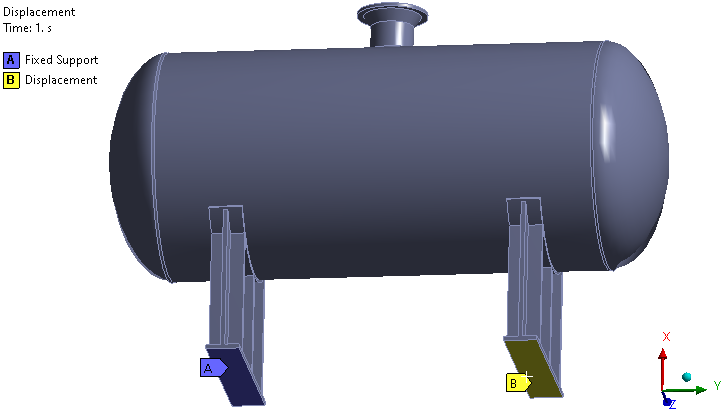Fixed Supports
‘Fixed support’ means fix or constraints all degrees of freedom of the selected entity. Fixed supports are the most widely used support type in FE analysis. As we know the DOF’s are not same for solid, shell or lines bodies and hence fixed supports in such cases will vary in terms of dof are discussed below;
- Solid bodies: It has three dof and hence provides constraints Ux, Uy & Uz.
- Shell or Line Bodies: It has six dof and hence provides constraints in (translational) Ux, Uy, Uz and (rotational) Rx, Ry, Rz.
Why do we apply fixed support ?
Fixed support represents all dof constraints scenario, meaning the selected entity does not move in any direction. In order to simulate such scenarios we do use fixed support. Examples; Support frame, Skid, Street lights base frames, Mounted bullet or Pressure vessel base/saddles, etc. In all this scenarios, the base holds the objects and it will not provide any movement to the object at a fixed location. Furthermore, Whenever boundary conditions are not clear, fixed support can be used to get more conservative FEA results.
Displacements:
Displacement is one of the types of support in FEA and it is used to apply the imposed translation displacements in X, Y, Z direction in the local or global coordinate system. If you are aware of the displacement values, then you can apply in respective directions and perform the simulation. It will move as per given displacement & then will stop the movement of the selected entity. For example, in some case we are aware of the displacement such as thermal expansion case, where we easily calculate thermal displacement from equation ΔL = α*L*ΔT. So instead of simulating thermal expansion case, we can directly apply the calculated displacement to see the last results. Like displacement on sliding support in case of pressure vessel. Furthermore, In case of reactors; there are so many different components connected to it and if you are analyzing any individual components, then you might need to consider the reactor’s movements in local components by applying displacement values in respective directions.
Fixed Support Vs Displacement
We always confuse these two terms while applying constraints in FEA. Does displacement constraints is the same as fixed supports, the answer to this question is Yes, but when all displacement values either rotational or translational are zero. It means that, if you provide displacement constraints to solid bodies as Ux, Uy & Uz as zero, then it is the same as fixed support.
Then the question might come to your mind, why displacement constraints are provided as separate support conditions ?
As discussed above, the displacement are useful to apply imposed translation displacements in X, Y & Z directions. It also useful to make free translational movement. There are scenarios in which you might need to allow few DOF’s to move freely: For example clamp supports in case of piping: in this case, the clamp will hold the pipe but it will not restrict the translation movement. Another example is pressure vessel sliding support; slotted holes are provided in one of the saddle (support) of the pressure vessel, which allows only some translation movement due to thermal expansion while other directional movement is restricted. Refer figure 1 for fixed support and displacement support conditions.

Summary:
- Fixed Supports are used to constraints all degrees of freedom
- Displacement supports are used for applying imposed displacements & free movements in respective direction (X, Y & Z) as per support condition.
- Displacement is same as Fixed support when all translation movement are zero.
